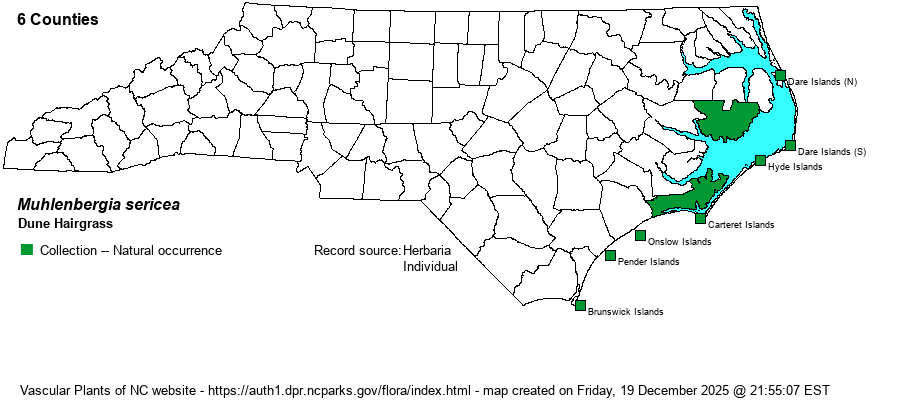| Author | (Michaux) P.M. Peterson | |
| Distribution | Outer Banks and other barrier islands; scarce on the mainland of the outer Coastal Plain (Radio Island in Carteret County, brackish marsh in Hyde County). The northern range limit is just north of Oregon Inlet, Dare County.
Maritime, NC to southern FL and southern TX. | |
| Abundance | Frequent on the Outer Banks and other barrier islands, but rare on the mainland. Sea Island residents in SC use it to make their famous straw baskets. Large populations color maritime grasslands pink. | |
| Habitat | Maritime wet grasslands, maritime dry grasslands, interdune swales, margins of brackish marshes. |
| Phenology | Flowering and fruiting late September-November. | |
| Identification | This is a very distinctive and beautiful grass, likely confused only with M. capillaris, Eragrostis spectabilis, and Digitaria cognata, which see. The inflorescence occupies half the plant's height. Its close relative M. capillaris occurs in mainland soils and has much shorter awns on the glumes (1-5 mm long vs. 2-25 mm long in M. sericea). | |
| Taxonomic Comments | In some works, treated as a variety or a subspecies of M. capillaris.
In NC the genus Muhlenbergia assumes 2 very different forms of inflorescences: very open and airy or narrow and elongate, with short branches. In both cases, attention to details of the key is important, along with a dissecting scope. Once learned, however, most muhlys can be identified on sight in the field. Spikelets contain a single floret (rarely 2-3). | |
| Other Common Name(s) | Sweetgrass, Slender Muhly, Gulf Hair-awn Muhly. This species simply lacks a well-used common name! | |
| State Rank | S3 | |
| Global Rank | G5? | |
| State Status | | |
| US Status | | |
| USACE-agcp | FACW link |
| USACE-emp | FAC link |

